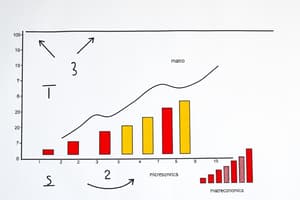Podcast
Questions and Answers
What is the primary focus of microeconomics?
What is the primary focus of microeconomics?
- The overall performance of national economies
- Government policies and their impacts on the economy
- Individual agents like consumers and firms (correct)
- The interactions of economies on a global scale
Which principle explains that as prices decrease, the quantity demanded increases?
Which principle explains that as prices decrease, the quantity demanded increases?
- Scarcity Principle
- Law of Supply
- Equilibrium Point
- Law of Demand (correct)
What does GDP measure?
What does GDP measure?
- The level of income inequality in a nation
- The rate at which consumer prices increase
- The employment rate among the workforce
- The overall economic output of a country (correct)
Which economic system emphasizes equal distribution of wealth?
Which economic system emphasizes equal distribution of wealth?
What is the primary goal of fiscal policy?
What is the primary goal of fiscal policy?
What does the term 'comparative advantage' refer to?
What does the term 'comparative advantage' refer to?
Which of the following best describes a mixed economy?
Which of the following best describes a mixed economy?
Which issue refers to the growing dependency of global economies on each other?
Which issue refers to the growing dependency of global economies on each other?
Flashcards are hidden until you start studying
Study Notes
Key Concepts in Economics
-
Definition: Economics is the study of how individuals, businesses, and governments allocate scarce resources to satisfy unlimited wants.
-
Branches:
- Microeconomics: Focuses on individual agents (consumers and firms) and their interactions.
- Macroeconomics: Examines the economy as a whole, including national income, inflation, and unemployment.
Fundamental Economic Principles
- Scarcity: The core problem in economics; resources are limited while human wants are unlimited.
- Supply and Demand:
- Law of Demand: As prices fall, quantity demanded increases, and vice versa.
- Law of Supply: As prices rise, quantity supplied increases, and vice versa.
- Equilibrium: The point at which supply equals demand, determining market prices.
Economic Systems
- Capitalism: Characterized by private property and free markets.
- Socialism: Emphasizes equal distribution of wealth and government control over resources.
- Mixed Economy: Combines elements of capitalism and socialism.
Key Indicators
- Gross Domestic Product (GDP): Measures a country's economic output and performance.
- Unemployment Rate: The percentage of the labor force that is jobless and actively seeking employment.
- Inflation Rate: The rate at which the general level of prices for goods and services rises.
Concepts of Trade
- Comparative Advantage: The ability of a party to produce a particular good or service at a lower opportunity cost than another.
- Trade Theories:
- Absolute Advantage: When a country can produce more of a good than another country with the same resources.
- Heckscher-Ohlin Theory: Suggests that countries export what they can most efficiently and abundantly produce.
Government Intervention
- Fiscal Policy: Government adjustments in spending and taxes to influence the economy.
- Monetary Policy: The control of the money supply and interest rates by a central bank to manage economic stability.
Current Economic Issues
- Globalization: The increasing interdependence of economies around the world through trade and investment.
- Income Inequality: The disparity in income distribution among individuals or groups.
- Sustainability: Balancing economic growth with environmental protection and resource conservation.
Tools of Economic Analysis
- Graphs and Models: Used to visually represent economic concepts such as supply and demand curves.
- Statistical Data: Essential for analyzing trends and making forecasts in economic performance.
Economic Theories
- Keynesian Economics: Advocates for government intervention to manage economic cycles.
- Classical Economics: Emphasizes free markets and the self-regulating nature of the economy.
- Behavioral Economics: Combines psychology and economics to understand how psychological factors influence economic decision-making.
Definition of Economics
- Economics examines how limited resources are allocated to fulfill unlimited desires by individuals, companies, and governments.
Economics Branches
- Microeconomics studies how individual consumers and businesses, and their interactions, impact the economy.- Macroeconomics looks at economic activity as a whole, focusing on macroeconomic variables like national income, inflation, and unemployment.
Fundamental Economic Principles
- Scarcity is the core economic issue, as limited resources must meet limitless demands.
- Supply and Demand explains how pricing is determined in markets:
- Law of Demand: As prices fall, more is demanded, and vice versa.
- Law of Supply: As prices rise, more is supplied, and vice versa.
- Equilibrium occurs when supply and demand balance, setting market pricing.
Economic Systems
- Capitalism is characterized by private ownership and free markets, where supply and demand dictates production and resource allocation.
- Socialism advocates for equal wealth distribution and government control over resources.
- Mixed Economy leverages components of both capitalism and socialism.
Key Economic Indicators
- Gross Domestic Product (GDP) measures a country's economic output and performance.
- Unemployment Rate is the percentage of the labor force not working but actively seeking employment.
- Inflation Rate measures the rate of increase in prices for goods and services.
Concepts of Trade
- Comparative Advantage occurs when an entity can produce a good or service at a lower opportunity cost than another.
- Trade Theories:
- Absolute Advantage means a country can produce more of a good than another with the same resources.
- Heckscher-Ohlin Theory suggests that countries export what they can most efficiently and abundantly produce.
Government Intervention
- Fiscal Policy involves government adjustments to spending and taxes to influence economic activity.
- Monetary Policy is the central bank's control of the money supply and interest rates to maintain economic stability.
Current Economic Issues
- Globalization: The increasing interdependence of economies worldwide through trade and investment.
- Income Inequality: The uneven distribution of income among individuals or groups within the economy.
- Sustainability: Striking a balance between economic growth and environmental protection, conserving resources in the long term.
Tools of Economic Analysis
- Graphs and Models: Used to visually represent economic concepts like supply and demand curves.
- Statistical Data: Essential for analyzing trends and forecasting economic performance.
Economic Theories
- Keynesian Economics supports government intervention to manage economic cycles.
- Classical Economics emphasizes free markets and the self-regulating capacity of the economy.
- Behavioral Economics combines psychology and economics to understand how psychological factors influence economic decision-making.
Studying That Suits You
Use AI to generate personalized quizzes and flashcards to suit your learning preferences.




